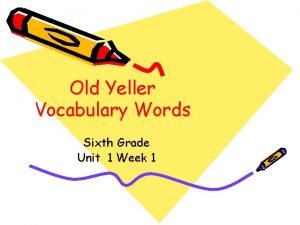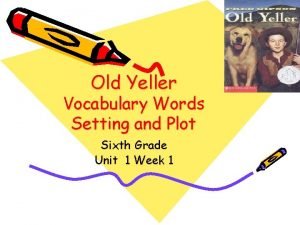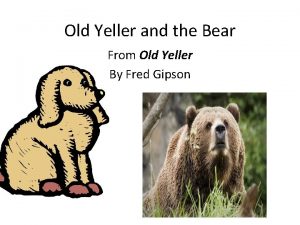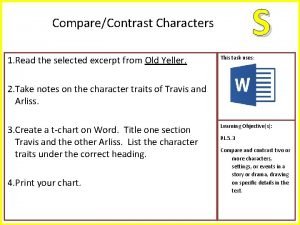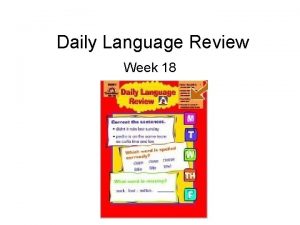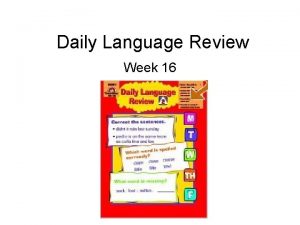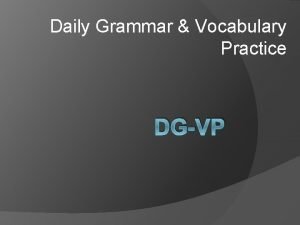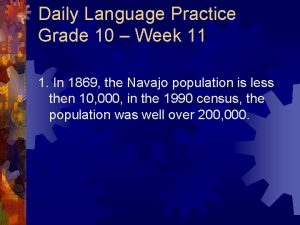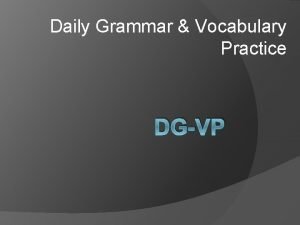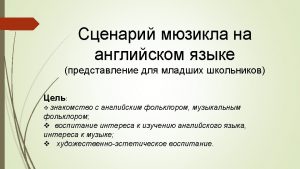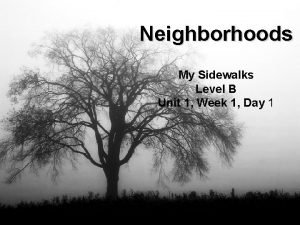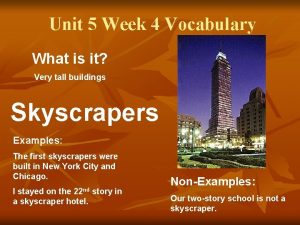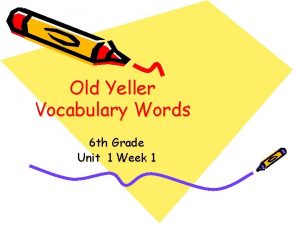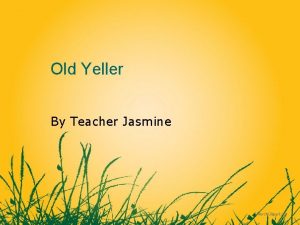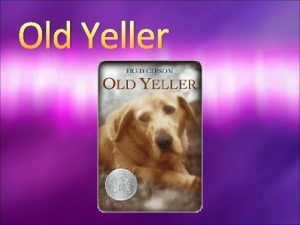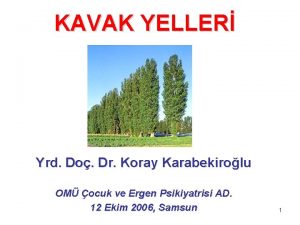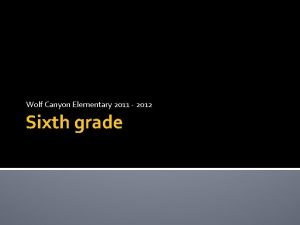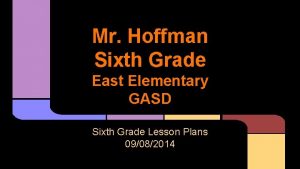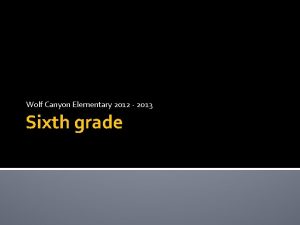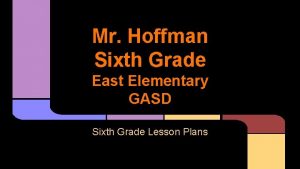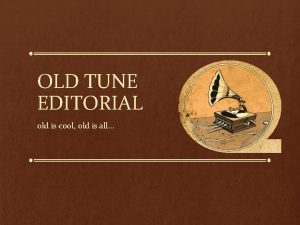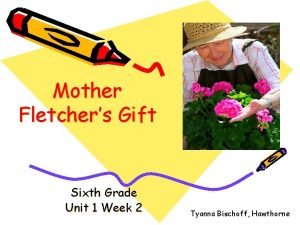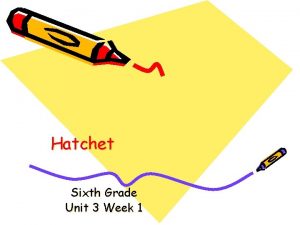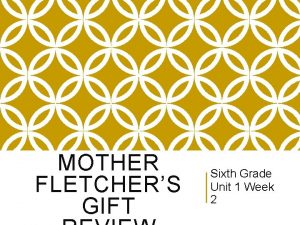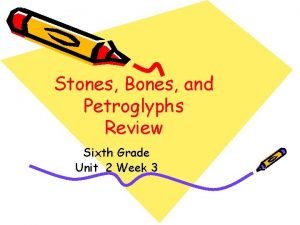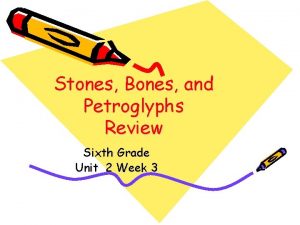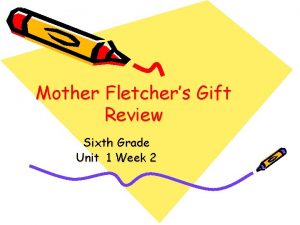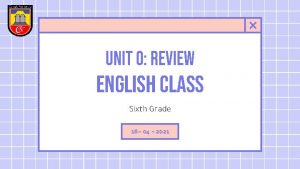Old Yeller Review Sixth Grade Unit 1 Week
























- Slides: 24

Old Yeller Review Sixth Grade Unit 1 Week 1

Words to Know lunging romping rowdy slung nub speckled

romping slung speckled nub lunging rowdy lunging moving forward suddenly; thrusting

nub romping slung speckled nub lunging rowdy A lump or a small piece.

romping slung speckled nub lunging rowdy speckled spotted; marked with many spots

romping slung speckled nub lunging rowdy romping playing roughly in a boisterous way

romping slung speckled nub lunging rowdy rough, disorderly, quarrelsome

romping slung speckled nub lunging rowdy slung thrown, cast, or hurled; threw

You’ve got it!

More Words to Know Endings —ed, ―ing You can use the ending of a word to help determine the word’s meaning. • The ending ―ed makes a verb show past action and the ending ―ing makes a verb show action that is going on right now.

More Words to Know Endings ―ed, ―ing • Sometimes the ―ed or ―ing form of a verb is used as an adjective, to describe. • The ending ―ed can also mean “having; characterized by, ”as in the sentence The long-legged dog could run quickly.

More Words to Know Endings ―ed, ―ing • Sometimes the ending ―ing forms a noun when it is added to a verb. In the following example, barking is a noun: The dog’s barking woke us up.

Setting • The time and place in which a story occurs.

Plot • The pattern of events in a story. – Usually events happen in a sequential order.

Exposition • Introduces characters, setting, and the basic situation.

Rising Action • Develops the conflict or problem; builds suspense or increases tension

Climax • The moment of greatest suspense, emotion, or interest (The most exciting part of a story. )

Falling Action • Reveals what happens after the climax.

Resolution • Reveals the final outcome and completes the falling action; when the reader learns how the conflict is resolved.

Conflict • The problem or struggle in a story.


Old Yeller Climax: tio Ac ing Ris on On the frontier of Texas in 1867, Travis, his mother, Arliss, and Old Yeller are left on the homestead while the father is away. cti Exposition g. A Arliss gets finned by a fish. Mama, Arliss, and Travis run home. llin Fa Travis takes off running after he hears Arliss screaming and the mama bear roaring while he chops wood. n Mama Bear charges toward Arliss because he won’t let go of the bear cub. Old Yeller attacks the mama bear. Conflict External- character vs. outside force Character vs. Character The Bear Resolution When everyone was out of danger, Old Yeller threw the fight to the mama bear and ran for home.

Text-Based Response Write a paragraph in your own words to describe a setting of the scene on page 30 of Old Yeller using the AEC format.

AEC Format • Answer/Assertion – (title, author, genre) • Evidence – (Prove it!) • Commentary/Explain – (Explain your evidence. )
 Old yeller spelling words
Old yeller spelling words Old yeller plot
Old yeller plot Old yeller bear
Old yeller bear Old yeller breed
Old yeller breed Old yeller characters
Old yeller characters Peter piper picked
Peter piper picked The sixth sick sheik's sixth sheep's sick lyrics
The sixth sick sheik's sixth sheep's sick lyrics Unit 6 review questions
Unit 6 review questions Transition words sixth grade
Transition words sixth grade Week by week plans for documenting children's development
Week by week plans for documenting children's development Algebra 2 unit 1 test
Algebra 2 unit 1 test 5 a day language review week 13
5 a day language review week 13 Daily language review week 18 answers
Daily language review week 18 answers Daily language review week 16 answer key
Daily language review week 16 answer key Dgp week 14 answers
Dgp week 14 answers Daily language practice
Daily language practice Week 10 dgp
Week 10 dgp What is your
What is your Once upon a time there lived a man
Once upon a time there lived a man Once upon a time there lived an old man and an old woman
Once upon a time there lived an old man and an old woman Once upon a time there lived a family
Once upon a time there lived a family Dgp week 9 answers
Dgp week 9 answers List of things a to z
List of things a to z Diving suit
Diving suit Unit 3 week 4 vocabulary
Unit 3 week 4 vocabulary
